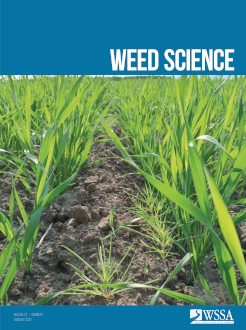Herbicides are the primary tool for controlling weeds in peanut (Arachis hypogaea L.) and are crucial to sustainable peanut production in the United States. The literature on chemical weed management in peanut in the past 53 yr (1970 to 2022) in the United States was systematically reviewed to highlight the strengths and weaknesses of different herbicides and identify current research gaps in chemical weed management. Residual weed control in peanut is achieved mainly with dimethenamid-P, ethalfluralin, pendimethalin, and S-metolachlor. More recently, the use of the protoporphyrinogen oxidase inhibitor flumioxazin and acetolactate synthase inhibitors, such as diclosulam, for residual weed control in peanut has increased considerably. Postemergence broadleaf weed control in peanut is achieved mainly with acifluorfen, bentazon, diclosulam, imazapic, lactofen, paraquat, and 2,4-DB, while the graminicides clethodim and sethoxydim are the major postemergence grass weed control herbicides in peanut. Although several herbicides are available for weed control in peanut, no single herbicide can provide season-long weed control due to limited application timing, lack of extended residual activity, variability in weed control spectrum, and rotational restrictions. Therefore, effective weed management in peanut often requires herbicide mixtures and/or sequential application of preplant-incorporated, preemergence, and/or postemergence herbicides. However, the available literature showed a substantive range in herbicide efficacy due to variations in environmental conditions and flushes of weed germination across years and locations. Despite the relatively high efficacy of herbicides, the selection of herbicide-resistant weeds is another area of increasing concern. Future research should focus on developing new strategies for preventing or delaying the development of resistance and improving herbicide efficacy within the context of climate change and emerging constraints such as water shortages, rising temperatures, and increasing CO2 concentration.
How to translate text using browser tools
24 November 2023
A Systematic Review of Chemical Weed Management in Peanut (Arachis hypogaea) in the United States: Challenges and Opportunities
Olumide S. Daramola,
Joseph E. Iboyi,
Gregory E. MacDonald,
Ramdas G. Kanissery,
Barry L. Tillman,
Hardeep Singh,
Pratap Devkota
ACCESS THE FULL ARTICLE

Weed Science
Vol. 72 • No. 1
January 2024
Vol. 72 • No. 1
January 2024
acetolactate synthase
chloroacetamides
dinitroaniline
herbicides
Weed interference





